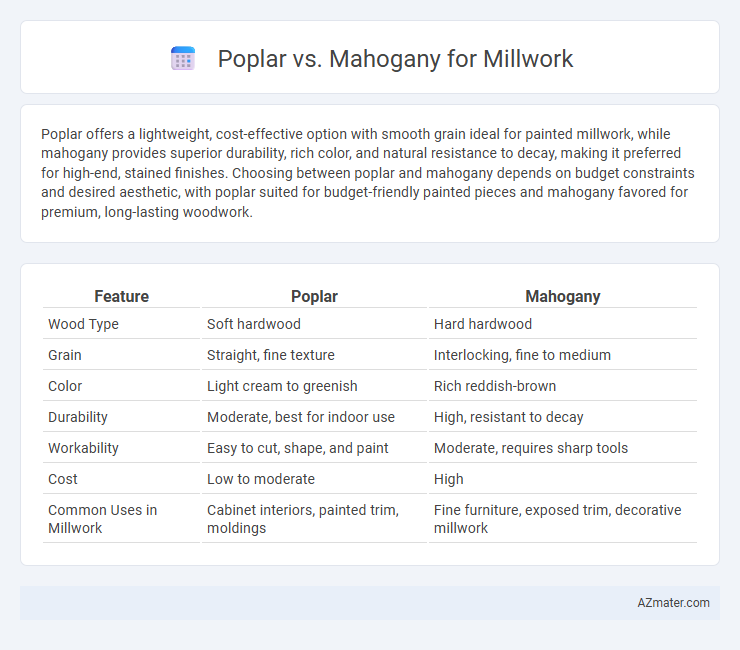Poplar offers a lightweight, cost-effective option with smooth grain ideal for painted millwork, while mahogany provides superior durability, rich color, and natural resistance to decay, making it preferred for high-end, stained finishes. Choosing between poplar and mahogany depends on budget constraints and desired aesthetic, with poplar suited for budget-friendly painted pieces and mahogany favored for premium, long-lasting woodwork.
Table of Comparison
| Feature | Poplar | Mahogany |
|---|---|---|
| Wood Type | Soft hardwood | Hard hardwood |
| Grain | Straight, fine texture | Interlocking, fine to medium |
| Color | Light cream to greenish | Rich reddish-brown |
| Durability | Moderate, best for indoor use | High, resistant to decay |
| Workability | Easy to cut, shape, and paint | Moderate, requires sharp tools |
| Cost | Low to moderate | High |
| Common Uses in Millwork | Cabinet interiors, painted trim, moldings | Fine furniture, exposed trim, decorative millwork |
Introduction to Poplar and Mahogany for Millwork
Poplar and mahogany are two popular hardwoods commonly used in millwork due to their distinct characteristics and applications. Poplar features a light color with a fine, straight grain that is easy to paint, making it ideal for interior trim, cabinetry, and decorative molding. Mahogany stands out for its rich, reddish-brown hue, exceptional durability, and natural resistance to decay, making it a preferred choice for high-end furniture, intricate carvings, and architectural millwork.
Wood Properties: Poplar vs Mahogany
Poplar wood is lightweight, soft, and easy to machine, making it ideal for intricate millwork requiring detailed carving and smooth finishes. In contrast, mahogany boasts a dense, durable structure with rich grain patterns, offering superior resistance to wear and moisture for long-lasting, elegant millwork applications. Both woods present different hardness levels, with poplar at Janka hardness 540 and mahogany averaging around 800 to 900, influencing their suitability based on project durability requirements.
Appearance and Grain Differences
Poplar features a light, creamy color with subtle green or gray undertones and has a relatively straight, uniform grain that provides a smooth surface ideal for painting. Mahogany displays a rich, reddish-brown hue with deep, interlocking grain patterns that create a luxurious, textured appearance prized in high-end millwork. The distinct color contrast and grain complexity make mahogany more suitable for natural finishes, while poplar's consistent grain lends itself better to stained or painted applications.
Durability and Longevity Comparison
Poplar offers moderate durability suitable for interior millwork but is prone to dents and scratches compared to mahogany, which is significantly harder and resistant to wear. Mahogany's superior density and natural oils enhance its longevity, making it ideal for high-end millwork requiring long-lasting performance. Choosing mahogany ensures a durable millwork solution with increased resistance to environmental factors and everyday use.
Workability and Machining
Poplar offers superior workability in millwork due to its softness and uniform grain, allowing for easy cutting, shaping, and sanding with minimal wear on tools. Mahogany, while harder and denser, provides excellent machining qualities, producing smooth finishes and precise detailing but requires sharper blades and slower feed rates to avoid tear-out. For projects emphasizing ease and speed in fabrication, Poplar is ideal, whereas Mahogany delivers durability and fine craftsmanship despite the increased machining effort.
Cost Considerations: Poplar vs Mahogany
Poplar offers a cost-effective option for millwork due to its abundant supply and faster growth rate, making it significantly more affordable than mahogany. Mahogany's rich color and durability come with a higher price tag, driven by its scarcity and slower maturation in tropical climates. Budget-conscious projects often favor poplar for its balance of workability and lower material costs, while mahogany is reserved for premium, high-end applications where visual impact and longevity justify the investment.
Finish Options and Stainability
Poplar offers excellent stainability and accepts paint and stains evenly, making it a versatile choice for millwork projects requiring a range of finish options. Mahogany naturally provides a rich, deep color with a smooth grain, enhancing finishes without heavy staining, ideal for high-end, polished looks. While poplar's lighter tone allows for greater customization in stains, mahogany's inherent beauty reduces the need for additional coloring, impacting the final aesthetic and maintenance.
Common Applications in Millwork
Poplar is widely used in millwork for interior trim, moldings, and painted furniture due to its smooth grain and affordability. Mahogany is favored for high-end millwork projects, including cabinetry, doors, and fine furniture, because of its durability and rich, deep color. Both woods offer versatility, but poplar is preferred for cost-effective, paint-ready applications, while mahogany provides an elegant, natural finish.
Sustainability and Environmental Impact
Poplar offers a more sustainable option for millwork due to its fast growth rate and availability from managed forests, resulting in less deforestation impact compared to mahogany, which often originates from slower-growing tropical trees facing overharvesting issues. The lower carbon footprint of poplar is attributed to shorter rotation cycles and less intensive harvesting practices, whereas mahogany's extraction contributes to habitat loss and biodiversity decline in tropical ecosystems. Using poplar supports eco-friendly millwork projects by reducing environmental degradation and promoting responsible forestry management.
Choosing the Right Wood for Your Millwork Project
Poplar offers affordability, ease of machining, and a smooth surface ideal for painted millwork, making it suitable for trim, moldings, and cabinetry where cost efficiency and versatility are priorities. Mahogany provides exceptional durability, rich color, and fine grain, making it perfect for high-end millwork projects requiring a luxurious finish and superior strength, such as custom furniture and detailed paneling. Selecting between poplar and mahogany depends on budget, desired aesthetics, and the end use of the millwork components to ensure the best balance of appearance and performance.

Infographic: Poplar vs Mahogany for Millwork
 azmater.com
azmater.com